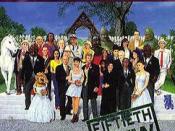Parallels between Metafictions Merriam-Webster?s Collegiate Dictionary defines the word metafiction as a ?fiction which refers to or takes as its subject fictional writing and its conventions.? In other words, a metafiction is a fictional story that tells another fictional story. Authors often use these types of stories to effectively express important themes they believe in. Fictional stories such as these include Margaret Atwood?s ?Happy Endings? and Grace Paley?s ?A Conversation with My Father.? Parallels between these two metafictions are shown by Atwood and Paley through similar situations within the stories, a common theme about looking past the plot of a story, and a common theme about endings.
One of the similarities between the two stories is the way that the authors describe the plot that is being told. In both these metafictions, the initial scenarios are simply descriptions of what is taking place. In Margaret Atwood?s ?Happy Endings,? ending A is just a plain list of events that has taken place.
?John and Mary fall in love and get married. They both have worthwhile and remunerative jobs which they find stimulating and challenging. They buy a charming house. Real estate values go up.? (19) The scenario continues on in a similar, uninteresting manner and concludes, ?Eventually they die. This is the end of the story.? (19) In Grace Paley?s ?A Conversation with My Father,? the narrator has been requested by her dying father to write him a simple story. She takes his words literally and gives him a plain and simple story about what happened to a woman who had a son. The son turned into a junkie at the age of fifteen, and in order to maintain her close friendship with him, the mother became a junkie too. The boy eventually gave it all up and left the city and his mother in disgust. (21) The dying father explains disgustedly to the narrator how she has practically left out everything a story is supposed to be consisted of. ?There are in fact Russian writers you never heard of who can write a plain ordinary story, who would not leave out what you have left out.? The father requests that the narrator retell the story, but this time paying more attention to detail. This time, she is able to add more depth to her story with intricate descriptions of her characters and their feelings. Describing the boy who became a junkie, she says, ?He was in fact hopeful, an ideologue and successful converter. With his busy brilliance, he wrote persuasive articles for his high-school newspaper.? (22) This additional information allows readers to know more about the character. It gives them a better understanding of the son, rather than just saying he was a boy who became a junkie. Similarly, Atwood?s endings B through F give more details on each character?s background. For example, in ending C, Atwood writes, ?John, who is an older man, falls in love with Mary, and Mary, who is only twenty-two, feels sorry for him because he?s worried about his hair falling out. She sleeps with him even though she is not in love with him.? (19) In both Paley?s and Atwood?s stories, the scenarios being described in the latter part of the stories contain more character analysis.
Another similarity between the two stories is the authors? common theme about looking past just what is happening in the plot of a story. In ?Happy Endings,? Atwood purposely shows a huge contrast in the amount of detail used between the first ending and the following endings. The additional information provided in endings B through F gives readers an understanding of why certain characters do the things that they do. Atwood wants to emphasize the importance of knowing the reasons behind why some things happen. ?That?s about all that can be said for plots, which anyway are just one thing after another, a what and a what and a what. Now try How and Why.? (20) A simple list of events has no effect on a reader because the reader would be unable to relate to what has taken place. The reader will lack an understanding of a certain character?s background and motives. In ?A Conversation with My Father,? Paley shows this common theme through the character of the father. He criticizes the first story told by the narrator about how it lacks the essential details a story needs. Even though he only asked for a plain, simple story, that does not mean a story can be missing those important details. The father asks the narrator, ?What were her parents like, her stock? That she became such a person. It?s interesting, you know. What about the boy?s father? Why didn?t you mention him? Who was he? Or was the boy born our of wedlock?? (22) Paley effectively uses the father to give the same message that Atwood gives about looking past what has happened, and to look it why and how it happened.
The last similarity between these two stories is the common theme about how stories end. Atwood and Paley describe all endings as being the same. No matter what it is that happens, the end will always conclude with death. Atwood says, ?You?ll have to face it, the endings are all the same however you slice it. Don?t be deluded by any other endings, they?re all fake.? She states that the only authentic ending is the one that she provides. John and Mary die. Atwood claims that any other ending is fake ?with malicious intent to deceive, or just motivated by excessive optimism if not by downright sentimentality.? (20) Similarly, Paley uses the father again to express this same idea. In the very last line of the story, he says, ?How long will it be? Tragedy! You too. When will you look it in the face?? The father is trying to get the narrator to accept the fact that he is dying. He tries to tell her that no matter what happens, the end will always result in death, and there?s no way she can change that. In their preceding conversation, when the father refers back to her story and expresses how tragic the end of a person is, the narrator begs, ?No, Pa, it doesn?t have to be. She?s only forty. She could be a hundred different things in this world as time goes on.? The narrator?s view on life is very optimistic and believes that everything does not have to have a tragic ending. She is obviously in denial about her dying father. This common theme that both stories share tells readers that there is truly only one possible ending, and that will always be death.
Similarities between ?Happy Endings? and ?A Conversation with My Father? are shown through similar situations within the stories, a common theme about looking past the plot of a story, and a common theme about endings. These metafictions tell a story of their own in order to share the authors? points of view. Many people tell stories to achieve different types of goals. Teachers may tell analogous stories to help students understand certain ideas better. Parents could tell their children a story in order to teach them a lesson. Whatever the instance may be, story telling has always been a useful tool to get a point across.







